Senile? Arthritic? Scavenged? Abandoned? Douglas Palmer* on the Sedgwick Museum’s giant Pliosaurus cf. kevani
Just over 60 years ago, in June 1952, the remains of a giant marine reptile known as a pliosaur were uncovered by a dragline excavator at Stretham, near Cambridge. At an estimated length of between 10 and 20 metres, the extinct predator was described in the local press as one of the biggest and most complete pliosaurs known. However, a more realistic estimate cuts it down to around 12 m long – the length of a standard bus.
Pliosaurs actively hunted fish and the squid-like cephalopods known as belemnites in the 100m-deep seas, which in Late Jurassic times (c.155 mya) flooded over the region represented by the British Isles today. A history of the find, its rather botched recovery and the complicated story of various attempts at interpretation and classification, has been published by a local geologist Dr Peter Hoare in the Proceedings of the Geologists’ Association 126 (2015) 381–389.
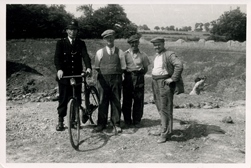
Picture: The Stretham pliosaur’s police guard in the person of PC Bill Lythell, the local ‘bobby’ along with some of the Great Ouse River Board staff (Cambridgeshire Collection, Central Library, Cambridge).
Found but not (fully) recovered
Such was the significance of the fossil and the popular interest it generated that the find spot was fenced off and the remains given police protection in the form of local Bobby PC Bill Lythell. The exact details of who first spotted the remains, and where, have not been firmly established; but the partly scattered bones of the huge skeleton were uncovered at Stretham where Kimmeridge Clay was being excavated for use in flood protection work by the Great Ouse River Board. And then, some of the bones were spotted when a load of excavated clay was dumped at Godmanchester (or so the story goes).
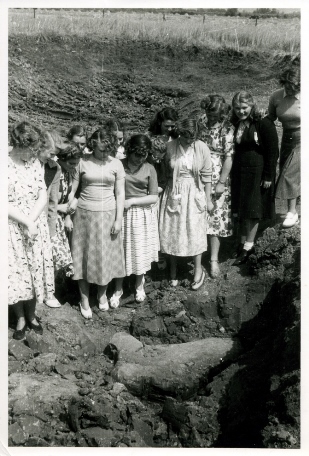
Picture: Some of the pliosaur’s local admirers (Cambridgeshire Collection, Central Library, Cambridge)
Dr O M B Bulman (1902–74), a Reader in Palaeozoology in Cambridge at the time (and subsequently Woodwardian Professor from 1955), was told of the find by a local dairy farmer Mr S R Hopkin and steps were taken to recover it. Other members of the Department of Earth Sciences and Sedgwick Museum who examined the remains included Maurice Black (1904–73, Reader in Sedimentary Petrology); Albert (Bertie) G Brighton (1901–88, Curator of the Sedgwick Museum); Brian Harland (1917–2003, Reader in Geology), Colin Forbes (1922–2014, Assistant Curator, 1954–67, and subsequently Curator the Museum 1967–83,) Michael House (1930–2002, then an undergraduate in Cambridge and latterly Professor and head of the Department of Geology at the University of Hull), along with Henry Brand, who was a Museum assistant from 1933 until 1980, and Stan Misson, who was a lab assistant in the 1950s.
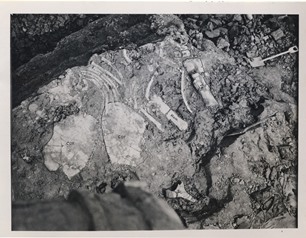 Picture (left): Photo taken on the 9 June 1952 of the disarticulated remains of the Stretham pliosaur, as seen on site from a vantage point of an elevated excavator bucket containing the photographer Dr Brian Harland. Annotations to the individual bones were added by Professor O M B Bulman viz. Cor – coracoid; Fe – femur; Fib – fibula; Hum – humerus; Sc – scapula, there are also a number of ribs but they are not annotated. (image archived SMES FRBS DDF Box 599,reproduced with kind permission of the Harland family)
Picture (left): Photo taken on the 9 June 1952 of the disarticulated remains of the Stretham pliosaur, as seen on site from a vantage point of an elevated excavator bucket containing the photographer Dr Brian Harland. Annotations to the individual bones were added by Professor O M B Bulman viz. Cor – coracoid; Fe – femur; Fib – fibula; Hum – humerus; Sc – scapula, there are also a number of ribs but they are not annotated. (image archived SMES FRBS DDF Box 599,reproduced with kind permission of the Harland family)
Despite local press claims about the amazing size and remarkable preservation, Forbes left notes indicating that the fossil was ‘so much broken as not to be worth the labour of collection’. Even so, Bulman supervised recovery of one of the huge paddle-like hind limbs, which was relatively complete despite being made up of many small bones, along with vertebrae, breast bones, ribs and part of the pelvis. Unfortunately, the skull seems to have been smashed by the excavator and it is likely that had it been preserved more effort would have been made to recover other remains.
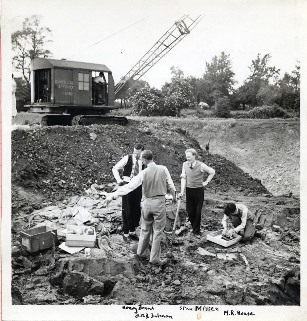 Picture (right): Photo taken on the 9 June 1952 of the disarticulated remains of the Stretham pliosaur, as seen on site from a vantage point of an elevated excavator bucket containing the photographer Dr Brian Harland. Annotations to the individual bones were added by Professor O M B Bulman viz. Cor – coracoid; Fe – femur; Fib – fibula; Hum – humerus; Sc – scapula, there are also a number of ribs but they are not annotated. (image archived SMES FRBS DDF Box 599,reproduced with kind permission of the Harland family)
Picture (right): Photo taken on the 9 June 1952 of the disarticulated remains of the Stretham pliosaur, as seen on site from a vantage point of an elevated excavator bucket containing the photographer Dr Brian Harland. Annotations to the individual bones were added by Professor O M B Bulman viz. Cor – coracoid; Fe – femur; Fib – fibula; Hum – humerus; Sc – scapula, there are also a number of ribs but they are not annotated. (image archived SMES FRBS DDF Box 599,reproduced with kind permission of the Harland family)
As it was, once the Museum staff had taken all they wanted there was still quite a lot of bone material left, and River Board personnel gave them to local schools (and more or less anyone who wanted them). Apparently, scores of people visited the site and carried away bits of fossil bone including a number of the dinner-plate-sized central portion of the vertebrae, which were subsequently used as doorstops. The Museum had collected just 69 bones, of which about half belonged to the really impressive two-metre-long hind paddle that is still on display in the Museum. The animal used the huge flat but flexible, paddle-shaped, limbs to propel itself through the water as if it were ‘flying’.
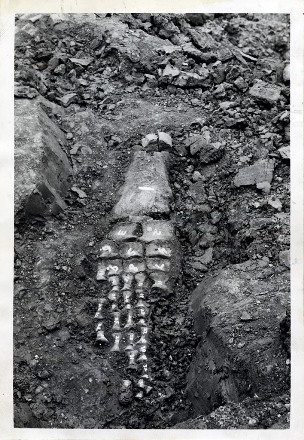
Picture (left): The near complete hind paddle of the ‘giant’ Stretham pliosaur with individual bones numbered prior to removal from the Kimmeridge Clay. The 2m long fossil is now on display in the Sedgwick museum. (Sedgwick Museum image archived SMES FRBS DDF Box 599)
Initial work on the fossil material by L B H Tarlo (1933–91, later known as Bev Halstead, Reader in Geology at the University of Reading) in the mid 1950s highlighted the potential importance of the find and led to the first of several attempts to recover the fossil material which had been given away. Then, in 1960, more bones were collected close to the original site in Stretham, so that the Museum now has around 165 bones, including 38 backbones, which altogether represent about 25% of the skeleton; although it is just possible that not all of the bones are from one individual.
By 1964 Tarlo’s detailed examination revealed signs of osteoarthritis in some of the bones from the neck and left hind limb, which was the only one to be recovered in any degree of completeness. The osteoarthritic ‘lipping’ of the edges of the bones can be clearly seen on the fossil displayed in the Sedgwick Museum. Tooth-marks were also spotted on some of the backbones and a rib-bone showing that there had been post-mortem scavenging of the carcass by some large predator, possibly another pliosaur.
Misnamed
The first formal description and naming of the fossil (by Tarlo, 1958) called it Pliosaurus macromerus; but he soon claimed that it was sufficiently distinct to be given a new name – Stretosaurus. However, he then realised that he had mistakenly identified one of the bones, which made the new name redundant, and suggested that it should revert to the name Liopleurodon, first established in 1873 for other fossil material. In recent decades even this identification has been questioned because of the incompleteness of the fossil remains and especially the lack of a skull.
In 2013, Roger Benson, who was a research fellow in the Department and is now an associate professor in the Department of Earth Sciences in Oxford, referred the Stretham pliosaur back to the original genus name Pliosaurus. This was the name that Tarlo used in 1958, and dates back to the 1840s when these kind of extinct marine reptiles were first found. The Museum also has a cast of a similarly large and even more complete Pliosaurus paddle found in 1839 within the Kimmeridge Clay at Kimmeridge, Dorset by John Mansel-Pleydell (1817-1902, St John’s College 1836-9), one of the founders of the Dorset County Museum, where the original is on display.

Picture (right): Plaster cast of a 2m long pliosaur paddle (P. macromerus) found at Kimmeridge, Dorset in 1839 (Sedgwick Museum photo by Matt Riley)
Undervalued Kevan?
More recently, a large (2m-long) pliosaur skull, also found in the Kimmeridge Clay of Dorset, is well enough preserved to allow Benson and his colleagues to describe a new species, which they call Pliosaurus kevani and dedicate to all “…the underestimated and undervalued Kevans of this world” after Kevan Sheehan, the collector who discovered it in June 2013. These authors also feel that the Stretham pliosaur might fit this particular ‘bill’ and tentatively named it Pliosaurus cf. kevani. It certainly has been ‘underestimated and undervalued’.
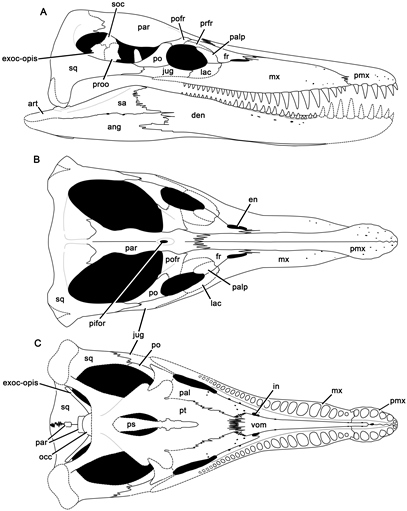
Picture (left): Reconstruction of the 2m long skull of Pliosaurus kevani found recently at Kimmeridge, from Benson RBJ et al., (2013) A Giant Pliosaurid Skull from the Late Jurassic of England. PLoS ONE 8(5): e65989. Doi:10.1371/journal.pone.0065989
References
- Benson R B J, Evans M, Smith A S, Sassoon J, Moore-Faye S, Ketchum H F and Forrest R (2013) A Giant Pliosaurid Skull from the Late Jurassic of England. PLoS ONE 8(5): e65989. Doi:10.1371/journal.pone.0065989
- Hoare P G (2015) Arthritic, scavenged and largely abandoned: the curious tale of a giant pliosaur from the Kimmeridge Clay at Stretham, Cambridgeshire, U.K. Proceedings of the Geologists’ Association 126, 381–389).
- Tarlo, L B (1958) The scapula of Pliosaurus macromerus Phillips. Palaeontology 1, 193–199.
Acknowledgments
My thanks to Dr Peter Hoare for permission to use his article and help in sourcing some of the photos. Sandra Last, the Sedgwick Museum archivist was, as usual very helpful with other images and information as was Matt Riley of the Sedgwick Museum and Dr Roger Benson, Dept Earth Sciences, University of Oxford.
*Douglas Palmer, author, is Public Programmes Coordinator for the Sedgwick Museum, Cambridge.